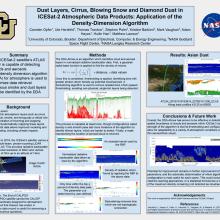Dust Layers, Cirrus, Blowing Snow and Diamond Dust in ICESat-2 Atmospheric Data Products: Application of the Density-Dimension Algorithm
Camden
Opfer
University of Colorado, Boulder
Poster
The objective of this talk is to share information about complex and typically hard-to-detect atmospheric layers in the ICESat-2 ATLAS data products, which may aid in reducing uncertainty in modeling energy fluxes in the Earth-Atmosphere system. Such layers include tenuous clouds such as cirrus and faint aerosols resultant from wildfires, distant volcanic eruptions, Asian and Saharan dust storms.
With the Advanced Topographic Laser Altimeter System (ATLAS), NASA's ICESat-2 carries the first space-born multi-beam micro-pulse photo-counting lidar altimeter system, operating at 532~nm and recording atmospheric observations at an along-track resolution of 280~m in three channels to a height of 14~km. The new sensor technology has required development of an entirely new algorithm for atmospheric layer detection and height measurement of layer boundaries. To solve these problems, we have developed the Density-Dimension Algorithm for analysis of atmospheric lidar data from NASA's ICESat-2, the DDA-atmos. The DDA-atmos is the operational algorithm for ICESat-2 ATLAS atmospheric data products. The DDA-atmos automatically adapts to the changing characteristics of daytime, night and dusk and yields layer boundaries at the original data resolution. A particular strength of the algorithm is its detection capability of different types of layers in complex data situations, such as layers at different altitudes and interspersed with other layers of varying optical depths. Examples of recorded layers include optically thin and thick clouds, blowing snow and diamond dust, as well as aerosols. New in the upcoming release~7 of the ICESat-2 data products is the detection of very faint Asian dusts, facilitated by a new algorithm component. Especially inclusion of novel information on aerosols resultant from dust storms, as well as detection and classification of blowing snow and diamond dust, is expected to aid in reducing uncertainty of energy flux modeling in times of a changing climate.
With the Advanced Topographic Laser Altimeter System (ATLAS), NASA's ICESat-2 carries the first space-born multi-beam micro-pulse photo-counting lidar altimeter system, operating at 532~nm and recording atmospheric observations at an along-track resolution of 280~m in three channels to a height of 14~km. The new sensor technology has required development of an entirely new algorithm for atmospheric layer detection and height measurement of layer boundaries. To solve these problems, we have developed the Density-Dimension Algorithm for analysis of atmospheric lidar data from NASA's ICESat-2, the DDA-atmos. The DDA-atmos is the operational algorithm for ICESat-2 ATLAS atmospheric data products. The DDA-atmos automatically adapts to the changing characteristics of daytime, night and dusk and yields layer boundaries at the original data resolution. A particular strength of the algorithm is its detection capability of different types of layers in complex data situations, such as layers at different altitudes and interspersed with other layers of varying optical depths. Examples of recorded layers include optically thin and thick clouds, blowing snow and diamond dust, as well as aerosols. New in the upcoming release~7 of the ICESat-2 data products is the detection of very faint Asian dusts, facilitated by a new algorithm component. Especially inclusion of novel information on aerosols resultant from dust storms, as well as detection and classification of blowing snow and diamond dust, is expected to aid in reducing uncertainty of energy flux modeling in times of a changing climate.

Opfer-Camden-Poster_0.pdf
(2.71 MB)
Meeting homepage
